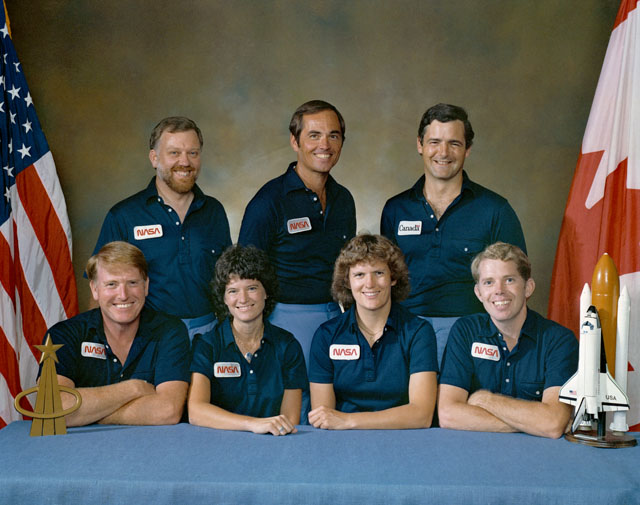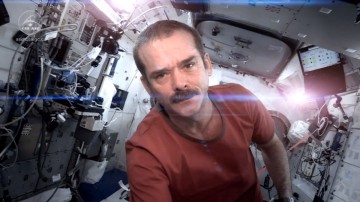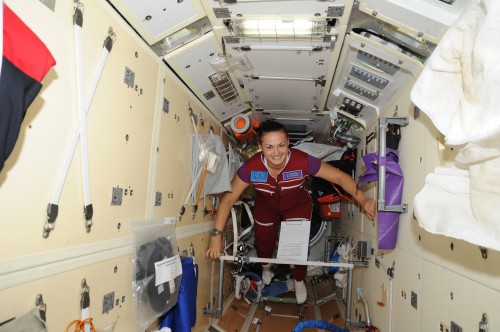
Thirty years ago yesterday (Oct. 5, 1984), STS-41G made history as Space Shuttle Challenger rocketed into orbit. Mission-wise, it was ambitious; according to an AmericaSpace article published days ago by Ben Evans, “On-board was the largest crew ever launched … During their eight days aloft, the crew of 41G deployed a large Earth resources satellite [Earth Radiation Budget Satellite, or ERBS], imaged the Home Planet with powerful synthetic aperture radar, and embarked on a risky EVA to rehearse techniques for the on-orbit fueling of future spacecraft.” (For those enamored of the early shuttle era, the IMAX film The Dream is Alive contains many highlights from this mission.)
However, the crew was also notable from a social standpoint, as it boasted the first Canadian in space (Marc Garneau), the first Australian-born citizen in space (Paul Scully-Power), and two women flying at the same time, one making a return to orbit after a glass ceiling-shattering first, one making the first U.S. EVA by a woman (respectively, Sally Ride and Kathryn Sullivan). The crew represented the increasingly diverse face of spaceflight in 1984. Since then, Canada’s space program has grown, and women in spaceflight have continued to make strides in the face of adversity, most recently evidenced as Elena Serova (Russia’s fourth female cosmonaut) rocketed to the International Space Station (ISS) just over a week ago.
Up until 1983, NASA in space had been represented by Caucasian men (predominantly test pilots, with a smattering of scientists) from its genesis; in addition, international “guests” (already flown on Salyuts 6 and 7 during the Soviet Intercosmos program) had not been flown as of yet aboard U.S. vehicles. During that year, several firsts were made as the first U.S. woman astronaut was launched on STS-7 (Sally Ride, who reluctantly became a celebrity during her first spaceflight), the first African-American astronaut flew during STS-8 (Guion “Guy” Bluford, who enjoyed a long career as he also flew on STS-61A, STS-39, and STS-53), and the first European Space Agency (ESA) payload specialist flew on STS-9/Spacelab 1 (German Ulf Merbold).
As 1983 progressed into 1984, space shuttle crews continued to grow more diverse, with the second African-American astronaut flying during STS-41B (Ronald McNair) and the first Jewish-American astronaut in space launched aboard the first Discovery mission (Judith Resnik on STS-41D). It seemed the “face” of the space shuttle program was finally reflecting face of the world, albeit in small ways. As 1984 closed out, milestones in Canadian spaceflight and space for women could be counted.

Canada already had made a momentous contribution to the shuttle program as the Shuttle Remote Manipulator System (SRMS, or most commonly known as “Canadarm”) had made its debut during November 1981’s STS-2 flight. This piece of hardware would become iconic, as it aided in payload deployment, retrieval, and construction duties during the shuttle’s 30-year history. While the shuttle program may have ended in 2011, its legacy is still felt, as the ISS’ Mobile Servicing System (MSS, consisting of Canadarm2, DEXTRE, and the Mobile Base) continues the spirit of cooperation between the U.S. and its Northern neighbors.
STS-41G’s addition of Marc Garneau (selected in 1983, transferred to the Canadian Space Agency in 1989) also began the era of the Canadian astronaut. Garneau would fly two more missions (STS-77 and STS-97) before retiring from spaceflight to go into politics.
In 2013, the Canadian Space Agency (CSA) gained widespread visibility as Chris Hadfield became the nation’s first ISS commander. In addition to that first, he also became somewhat of a celebrity as he made well-received educational videos discussing various phenomena in space; at the end of his mission, he released a truly “out of this world” version of David Bowie’s “Space Oddity” which garnered millions of hits on YouTube. Just last week, NASA administrator Charlie Bolden (former shuttle astronaut, and first African-American NASA Administrator to serve permanently) related during an event in Ottawa, “My notes say [Chris Hadfield is] famous. Chris is not famous! Chris is infamous. Chris has revolutionized the way that people look at astronauts on orbit and he has brought spaceflight home to normal people down here. He has made them feel like: I can do this. I’m involved in this. And that’s really, really, really special.” Bolden is on point: Hadfield did make space seem accessible to people all over the world.
While Hadfield retired following his return to Earth last year, two CSA astronauts are still awaiting their spaceflight missions (Jeremy Hansen and David Saint-Jacques). As far as spaceflight is concerned, Canada’s influence is here to stay through its heritage, people, and hardware.
Women in space have also continued to make strides throughout the last three decades. In 1999, United States Air Force flyer Eileen Collins rocketed into history as she became the first female space shuttle commander on STS-93. In 2007, the spaceflight world saw two women commanders in space at the same time, as Peggy Whitson (ISS Expedition 16 commander) and Pam Melroy (STS-120 commander) met up on the international outpost in space. Most recently, the U.S. saw astronaut Karen Nyberg fly to the ISS in 2013. In the U.S., the idea of a “woman astronaut” no longer raises (many) eyebrows.

In Russian space news, just over a week ago Elena Serova became merely the fourth Russian woman to fly to space, but not without some controversy as she was met with questions about her daughter’s stability, her hairstyle, and her makeup during the requisite pre-flight press conference. However, she met the intrusive line of questioning like the professional she is: “Can I ask a question, too: Aren’t you interested in the hairstyles of my colleagues? My flight is my job. I feel a huge responsibility towards the people who taught and trained us and I want to tell them: We won’t let you down!” Serova seemed to not just speak for herself, but for all women with careers taking them away from the home front.
While it’s notable that the last U.S. astronaut class selected in 2013 is half comprised of women, Russia’s space program still seems resistant to the idea of women in orbit. The late Vladimir Popovkin (former head of Russia’s federal space agency) said of Serova in a Guardian article: “We are doing this flight for Russia’s image. She will manage it, but the next woman won’t fly out soon.” It is hoped that Serova’s flight is seen as a credit to women in space in her home nation, not as “an exception to the rule.” In future months, the ESA is set to send Italian astronaut Samantha Cristoforetti into orbit for ISS Expedition 42/43, while the U.S. is currently preparing astronaut Kathleen Rubins for a long-duration ISS mission (Expedition 48/49).
As spaceflight begins its next “era” branching into commercial spaceflight, more ISS expeditions, and future deep space missions, diversity in space—spearheaded in part by those early “Golden Era” shuttle missions such as STS-41G—will continue to prove that space, indeed, is a place for everyone.
Want to keep up-to-date with all things space? Be sure to “Like” AmericaSpace on Facebook and follow us on Twitter: @AmericaSpace




May be my favorite piece you’ve done. Good work!
Good article but why does it not cover the Chinese contribution?
They too had put a woman in space.